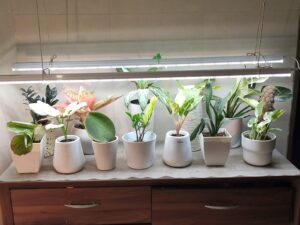
Indoor farming has emerged as a solution to many of the challenges faced by traditional outdoor agriculture, such as limited space, seasonal restrictions, and unpredictable weather conditions. At the heart of this revolution is the use of LED grow lights, which provide artificial lighting that mimics natural sunlight. These lights allow plants to grow indoors in controlled environments. While LED grow lights offer numerous advantages for indoor farming, there are also some drawbacks to consider. Here’s a breakdown of the pros and cons of using LED grow lights for indoor farming.
Pros of LED Grow Lights in Indoor Farming
- Energy Efficiency
One of the primary benefits of LED grow lights is their energy efficiency. Compared to traditional lighting systems like high-pressure sodium (HPS) or fluorescent lights, LEDs consume significantly less energy. This is a critical advantage for indoor farms, where lighting can account for a large portion of operational costs. LED grow lights convert more electricity into usable light, minimizing energy waste and reducing electricity bills.
- Customizable Light Spectrum
LED grow lights offer a full spectrum of light that can be customized to meet the specific needs of plants at different growth stages. Blue light is ideal for the vegetative stage, while red light promotes flowering and fruiting. This ability to tailor the light spectrum ensures that plants receive the optimal wavelengths for growth, leading to healthier crops and higher yields.
- Long Lifespan
LED grow lights have a much longer lifespan compared to traditional lighting systems. On average, LED lights last up to 50,000 hours or more, meaning they need to be replaced far less frequently than HPS or fluorescent bulbs. This reduces maintenance costs and minimizes the disruptions associated with replacing light fixtures, making LED grow lights a more cost-effective long-term investment.
- Lower Heat Output
LED grow lights generate significantly less heat than traditional lighting options. This is particularly important in indoor farming, where excessive heat can stress plants, slow growth, and increase the need for cooling systems. With LED grow lights, farmers can place the lights closer to plants without the risk of overheating, leading to more efficient light distribution and better crop performance.
- Year-Round Production
With LED grow lights, indoor farmers are not dependent on natural sunlight. This allows for continuous, year-round crop production, regardless of the season or climate. This capability is especially valuable in regions with harsh winters or limited daylight, where outdoor farming is less viable.
Cons of LED Grow Lights in Indoor Farming
- High Initial Investment
One of the main drawbacks of LED grow lights is their upfront cost. While they offer significant long-term savings due to their energy efficiency and long lifespan, the initial investment required to purchase high-quality LED systems can be expensive. This can be a barrier for small-scale farmers or those with limited budgets.
- Technical Complexity
While LED grow lights offer customizable light spectrums, this flexibility can also be a challenge for beginners. Understanding the specific light requirements for different crops and growth stages requires a learning curve, and improper light spectrum or intensity settings can result in suboptimal plant growth. Farmers new to indoor farming may need to invest time and resources in understanding how to adjust LED grow lights for maximum efficiency.
- Coverage Limitations
Depending on the size and type of LED grow lights, their coverage area may be limited. This means multiple light fixtures may be required to adequately cover larger growing spaces, increasing the overall cost of the system. Additionally, placing lights too close together or too far apart can lead to uneven light distribution, potentially affecting plant growth.
- Initial Setup Costs for Infrastructure
While LED grow lights themselves can be expensive, setting up an indoor farm also requires other infrastructure, including ventilation, irrigation, and temperature control systems. The combination of these setup costs can make starting an indoor farm a significant financial investment, though the long-term benefits often outweigh the initial expenses.


Indoor Farming with LED Grow Lights: Pros and Cons







